LoveRPi, a distributor and reseller of electronic boards and accessories, has run benchmarks from the Phoronix Suite on several low cost development boards:
- $46* Banana Pi M2 based on Allwinner A31s quad core Cortex A7 processor @ 1.0 GHz with Armbian (Ubuntu 14.04)
- $74* Banana Pi M3 based on Allwinner A83T octa core Cortex A7 processor @ 1.80 GHz with Debian 8.3
- $32 ODROID-C1+ based on Amlogic S805 quad core Cortex A5 processor @ 1.5 GHz with Ubuntu 14.04
- $40 ODROID-C2 based on Amlogic S905 quad core Cortex A53 processor @ 2.0 GHz with Ubuntu 16.04
- $74 ODROID-XU4 based on Samsung Exynos 5422 quad core ARM Cortex-A15 @ 2.0GHz quad core ARM Cortex-A7 @ 1.4GHz with Ubuntu 15.10
- $10 Orange Pi One based Allwinner H3 Cortex A7 processor @ 1.2 GHz with Armbiam (Debian 8.3)
- $15 Orange Pi PC based on Allwinner H3 Cortex A7 processor @ 1.3 GHz with Armbiam (Debian 8.3)
- $39 Orange Pi Plus based on Allwinner H3 Cortex A7 processor @ 1.3 GHz with Armbiam (Debian 8.3)
- $35 Raspberry Pi 2 based on Broadcom BCM2836 quad core Cortex A7 processor @ 900 MHz with Raspbian
- $35 Raspberry Pi 3 based on Broadcom BCM2837 quad core Cortex A53 processor @ 1.2 GHz with Raspbian
* Banana Pi boards price includes shipping, while all other boards do not. The total price for each board may vary a lot for your country depending on shipping and local taxes.
 The 7 benchmarks John The Ripper (password cracker), C-Ray (raytracer), Smallpt (illumination renderer), Himeno Benchmark (solver of pressure Poisson), OpenSSL, FLAC audio encoding, and Timed MAFFT alignment are mostly stressing the CPU’s integer and floating-point unit either for single thread or multi-thread performance, so other parts such as storage should have very little impact on the scores.
The 7 benchmarks John The Ripper (password cracker), C-Ray (raytracer), Smallpt (illumination renderer), Himeno Benchmark (solver of pressure Poisson), OpenSSL, FLAC audio encoding, and Timed MAFFT alignment are mostly stressing the CPU’s integer and floating-point unit either for single thread or multi-thread performance, so other parts such as storage should have very little impact on the scores.
The table shows the Cortex A15 based ODROID-XU4 is ahead in most benchmarks, and from a CPU performance perspective deserves its higher price, while the Raspberry Pi 2 is now clearly the slowest of the bench.
 John The Ripper is the only test where ODROID-XU4 is outperformed, and the eight cores clocked at 2.0 GHz of Banana Pi M3 makes it the best boards of the lot, if you want to crack passwords with a cheap board. Interestingly Orange Pi boards performance is not that far of the one of Raspberry Pi 3.
John The Ripper is the only test where ODROID-XU4 is outperformed, and the eight cores clocked at 2.0 GHz of Banana Pi M3 makes it the best boards of the lot, if you want to crack passwords with a cheap board. Interestingly Orange Pi boards performance is not that far of the one of Raspberry Pi 3.
 FLAC audio encoding must mostly relies on single thread performance as ODROID-XU4 is clearly ahead here. For this particular task a $10 Orange Pi One board will do just as well as a $35 Raspberry Pi 3.
FLAC audio encoding must mostly relies on single thread performance as ODROID-XU4 is clearly ahead here. For this particular task a $10 Orange Pi One board will do just as well as a $35 Raspberry Pi 3.
If you want another take on Raspberry Pi 2 & 3 benchmarks, Mikronauts recently posted different benchmarks comparing the boards to ODROID-XU4, ODROID-C1+, LeMaker Guitar (Actions Semi S500 Cortex A9 processor), MIPS Creator CI20, etc…
Of course benchmarks are only one part of the story as you also need to consider the interfaces, system memory (e.g. there’s usually no difference between a system with 1GB RAM and one with 2GB RAM in benchmarks), and other requirements for your project or use case.

Jean-Luc started CNX Software in 2010 as a part-time endeavor, before quitting his job as a software engineering manager, and starting to write daily news, and reviews full time later in 2011.
Support CNX Software! Donate via cryptocurrencies, become a Patron on Patreon, or purchase goods on Amazon or Aliexpress. We also use affiliate links in articles to earn commissions if you make a purchase after clicking on those links.




It should be noted that the tests with Banana Pi M3 were made with a SinoVoip OS image and not Armbian (we thought about suppporting the M3, I already made an image but we dropped the whole idea since it’s not worth the efforts). Due to the settings used the Banana Pi M3 doesn’t perform as it could (SinoVoip obviously has no clue how to increase the single threaded clockspeed to 2.2GHz so it remains at 1.8GHz, throttling settings are bad and negatively affect performance and so on).
And all these numbers above are pretty useless when you want to know how the SBC in question behaves in real world situations or in specific use cases. Need highest network and I/O performance? ODROID XU4 wins with both GbE and USB3.0! Need highest ‘Linux desktop’ performance? ODROID-C2 combined with fast eMMC with peak single threaded performance and highest random I/O wins. Need cheap allrounder that is able to play HEVC/1080p video HW accelerated? Orange Pi PC/One wins. Addicted to marketing? Rasp…
For the first time I am reading Orange pi wins..
Good reference!
@Jean Dassi Fongang
This is only a good reference when your use case is ‘running unoptimised code in unpredictable manner’ 24/7 on a device. In case you want to run ‘real tasks’ on the board many other things are way more important than ‘fire and forget benchmarks’ measuring irrelevant stuff.
For example on Banana Pi M3 only one of the 2 USB host ports is used and the USB-to-SATA bridge on the board is probably the slowest in the world (15MB/s write speed max). When you run demanding stuff on this board without a heatsink due to the moronic throttling settings the vendor uses CPU cores are killed immediately due to overheating and you end up with a quad-core board (the results from LoveRPi were made with heatsink and fans — using a fan or not with M3 means loosing half of the performance, see below!). So while the M3 shines in these round of PTS benchmarks in reality it performs different.
Same applies to the 2 ARMv8 boards. If the PTS ‘benchmarks’ would use optimised compiler settings both RPi 3 and ODROID-C2 scores would explode in some tests. So what are the scores above for? If I’m interested in performance then I will use performance settings (compiler switches) and then some of the performance scores are 8-10 times better (see the last 4 BPi M3 results here for example).
@tkaiser
A) “And all these numbers above are pretty useless when you want to know how the SBC in question behaves in real world situations or in specific use cases.” LOL
B) Any news of 1GB (or 2GB!) RAM version of Orange Pi One?
@onebir
A) Any news of a 1.2 GHz RPI Zero
B) Any news of a 1GB, 2GB RPI Zero? Oh I forgot the RPI Zero soc cannot handle more than 512mb
C) Any news of RPI Android on the RPI Zero.
The above test should of included real world software non programming people use like Android, how is RPI at Android use?
@onebir
I don’t think a One with 1GB will ever be available (why not choose the PC for $15 instead?). If it’s about small size you could also have a look at Banana Pi M2+ or NanoPi M1 (when available with 1GB). Both manufacturers chose to stay as compatible as possible to the Oranges so only minor tweaks are necessary to support them.
BTW: I created a mainline kernel Armbian image an hour ago, running with kernel 4.6-rc1 on Orange Pi PC with ‘alpha’ Ethernet driver and get already ~95/85 MB/s (a few RX errors and timing issues are responsible for slower throughput in one direction). Kudos to the linux-sunxi community for their great work!
These tests were done with reference OSes. Armbian for Banana Pi M2 and Orange Pi. SinoVOIP’s Debian image for the M3. Raspbian for Raspberry Pi. We did not use any special flags to set compiler optimizations so this is a good reflection of out of the box performance. If the Raspberry Pi Foundation elects to create a ARMv8 Raspbian, we will retest and we do expect better performance.
@tkaiser
Thanks – sorry for my ignorant question; didn’t know about these plans:
“[Orange Pi] Plus 2 will use 2GB RAM with Allwinner H3, Pi 3 willl use 1GB/2GB RAM with Allwinner H64”
http://www.orangepi.org/orangepibbsen/forum.php?mod=viewthread&tid=521&extra=page%3D1
~90% of theoretical max on 100M ethernet is already ‘adequate’! (Esp for $10 hardware! 😉
@No Ta
Whut?
@tkaiser
its becos of you guys, the linux-sunxi community that prevent most of all-winner based product from becoming an Orange Pi Brick.
hahahahaha…..
i agree with that this is only a reference for bechmarking setting, which is unreliable in at best for real world usage.
need more test with diff sw.
You should run SLAMbench on the various boards. It is also a pretty interesting paper, since it boils down SLAM to frames per watt. They test some CUDA implementations, and show that nvidia hardware is way ahead of everyone.
I ran SLAMbench on a TX1 module and got 50fps!
http://apt.cs.manchester.ac.uk/projects/PAMELA/tools/SLAMBench/
I thought Amlogic S805 is Cortex A5 not A7 as mentioned in the top list….
@olin
and you thought correctly… 🙂
The text mentions at several places ODROID-XU7 but the tables etc mention XU4 and no mention of XU7. Typo?
@FransM
Fat finger issue. I could only find the error in one place though. Corrected.
@Andrew P
Very interesting paper indeed 🙂 but getting back to the subject : Low cost development board, we cannot consider the Nvidia TX1 as being in this category (and price range !!)
So what wins at controlling solenoids in a garden watering/irrigation system 😉
rpi wins for a desktop for a kid ?
@Al
ESP8266 🙂
@milkboy
This ( http://goo.gl/7qAjtr ) Orange Pi-PC is refusing to be bricked !
The tests are useful to a tinkerer with 24/7 headless needs.
Costs aren’t reflective of a PC style device, though, nor are the tests. Need a case, Power, HDMI cable, ethernet cable unless connecting wireless. And this says nothing about ability to give a good experience. Hardware acceleration of video as well as OpenGL depend on hardware, drivers, and OS. But tests generally only focus on the hardware capabilities. It’s worthless without reliable, efficient drivers.
Also SD card needed unless EMMC available. That’s more cost for some devices, and it’s a particularly relevant performance issue also.
Quirky 8.0.25 alpha for Raspberry Pi2 and Pi3
http://barryk.org/news/?viewDetailed=00426
think it also goes on odroid-xu4
“The current build of Quirky, 8.0.25, for the Raspberry Pi2, Pi3 and Odroid XU4”
about 350 MB